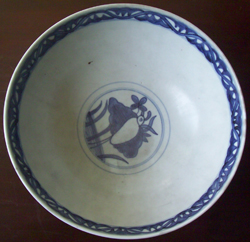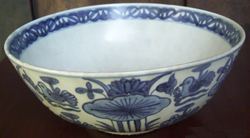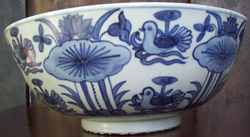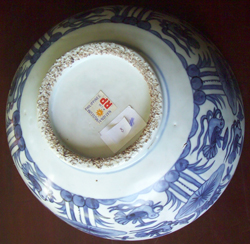



The
Story of
Blue and White
Porcelain
Blue and White
Porcelain is probably the most celebrated of all Ceramic Art styles ever produced
-- or at least the continuing outrageous enthusiasm of
auction buyers gives this impression.
Known
as "Qinghua" in China, the style was well developed by the
Yuan Dynasty (1271 - 1368) but became world famous during the Ming
Dynasty (1368 - 1644). Even today, many people use the terms
"Ming" "Blue and White" synonymously.
The decorative style became the standard for
Imperial Porcelain production in China and was much revered throughout Southeast Asia and the Middle-East because of vast trade networks existing since ancient times.
The
western affection for Blue and White Porcelain began in 1603 when the
Dutch East India Company sent a single ship to Amsterdam with a load
of the "Chinese White Gold." It was sold for a colossal
profit and the rest of Europe soon caught on. The affection for Blue and White
Porcelain continues relentlessly today.
The
center of production of Underglaze Blue Ceramics in China was
Jingdezhen in Jianxi Province.
It was here that ample raw materials (such as 2 mountains of
white kaolin clay) were available.
Chinese potters developed the technique of painting blue cobalt
oxide on white clay and spraying a coating of clear glaze over top.
When heated in a kiln at high temperature, the ceramic and its decoration can remain in mint condition for centuries even if buried underwater or
underground.
Although
imperial kilns in the Jingdezhen area were important, other locations
such as Shantou (Swatow), Dehua and other parts of Fujian province
also produced tradeware Porcelain that is found throughout Southeast
Asia.
|
Large Bowl with Double Ducks CERAMIC ARTIFACT
#bw-000808
DESCRIPTION:
The
large Blue and White bowl has 2 main decorative features. The
first is the Lingzhi fungus (representing long-life) on the inside of
the bowl.
The second is a water scene with 2 ducks on the outside of the
bowl. Ducks were thought to mate for life and represent marital happiness. The piece was probably meant to
be given as a gift for a joyous occasion such as a wedding. There
is sand around the foot rim as is common for artifacts of this
type.
ORIGIN:
The
artifact
was produced in China,
probably in the city of Jingdezhen of Jiangxi province. It was
brought to Southeast Asia as a valuable trade-good probably by an ancient
Spanish trading ship. After many centuries,
the piece was rediscovered and subsequently acquired by The Chalre Collection through a registered dealer.
AGE:
The
artifact originates from the Early
Qing Dynasty (1644 - 1911).
MEASUREMENTS:
Height: 12.5cm
(5in.)
Width or
Depth: 30.5cm (12in.)
REFERENCES:
Similar
or identical artifacts are found in various Ceramic Art publications.
Some of these include: Blue and White Wares Found in the
Philippines, Chinese Ceramics,
Chinese Blue
and White Porcelain, Blue and White Chinese Porcelain
and Zhangzhou
Ware.
Other similar or identical examples can be found in publications dealing
specifically with ancient shipwrecks excavations. Good examples
are Lost
At Sea: The Lena Shoal Junk and The
Pearl Road: Tales of Treasure Ships.
Similar
and/or identical
items are also on display at the Victoria & Albert Museum in London
(UK), the Asian Art Museum in San Francisco (USA), the National Museum
of Malaysia (Kuala Lumpur), the National Museum of the Philippines
(Manila) and
other museums
throughout the world with diverse collections of Asian ceramics.

|